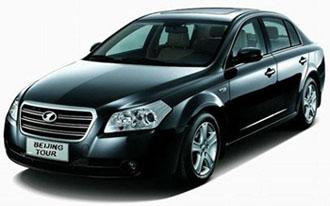[TJPORT 20]
Day 01: Tianjin port-Beijing (L)

After you disembark your ship, your
English-speaking guide and driver will be there to meet you and help you
with your luggage. We'll then make the drive to the outskirts of Beijing
in order to visit the Great Wall at Mutianyu. Although it has gotten a
face-lift, it avoids the army of tourists that plague Badaling. Mutianyu
offers some breathtaking views of the valley and wall below, and if you
look to your right you'll see a large sign engraved in the side of the
mountain encouraging you to Cherish the teachings of Chairman Mao. Mutianyu has also become popular for visiting foreign leaders and
celebrities (former U.S. President Clinton visited Mutianyu on one of
his trips to China).
You can hike down to the parking lot, take a cable
car, or take a toboggan ride (highly recommended, and lots of fun!) down
to meet our driver.
Following lunch we'll go to the Summer Palace. Being
northwest of the city center, the Summer Palace has the largest royal
park and being well preserved, the Summer Palace is ranked amongst the
most noted and classical gardens of the world. In 1998, UNESCO listed it
as one of the World Heritage Sites. Like most of the gardens of Beijing,
it could not elude the rampages of the Anglo-French allied force of 1860
and was destroyed by fire. In 1888, Empress Dowager Cixi embezzled navy
funds to reconstruct it for her own benefit, changing its name to Summer
Palace (Yiheyuan). She spent most of her later years there, dealing with
state affairs and entertaining. Highlights not to be missed are climbing
Longevity Hill, viewing the Empress Dowager Cixi's extravagant Marble
Boat, and talking a walk down Suzhou jie, a canal meant to resemble the
beautiful river city of Suzhou.
You will then be driven to your hotel in Beijing,
ending the day's activities.
Day 02: Beijing-Tianjin Port (L)
After being picked up in your hotel at about
8:00am, we will head over to the political center of the country,
Tiananmen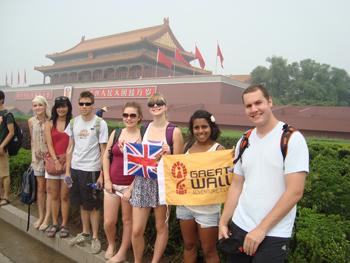 Square. The largest public square in the world, Tiananmen
Square is seen as China's political center. Its grounds have seen some
turbulent moments, from the May 4th Movement of 1919 to the political
turmoil of 1989. The south of the square is marked by the Chairman Mao
Memorial Hall, while the center of the square is dominated by the
Monument to the People's Heroes, an imposing 10-story granite obelisk.
To the east is the National Museum of China, and to the west is the
Great Hall of the People, home to China's legislative bodies. The north
of the square is dominated by the Gate of Heavenly Peace, known for its
iconic portrait of Mao Zedong, and is the national emblem of China.
Square. The largest public square in the world, Tiananmen
Square is seen as China's political center. Its grounds have seen some
turbulent moments, from the May 4th Movement of 1919 to the political
turmoil of 1989. The south of the square is marked by the Chairman Mao
Memorial Hall, while the center of the square is dominated by the
Monument to the People's Heroes, an imposing 10-story granite obelisk.
To the east is the National Museum of China, and to the west is the
Great Hall of the People, home to China's legislative bodies. The north
of the square is dominated by the Gate of Heavenly Peace, known for its
iconic portrait of Mao Zedong, and is the national emblem of China.
After walking across the street, we will enter what
is perhaps the greatest attraction in China, the Forbidden City. After
walking across the square we will enter the Forbidden City (known in
Chinese as Gu Gong), the largest surviving palace complex and the former
home of the emperors of the Ming and Qing Dynasty. The Forbidden City is
one of the greatest attractions in the world. Built by the third Ming
emperor between 1406-1422, the Forbidden City served as the official
residence to the Emperor of China until the last emperor, Puyi, was
forced to evacuate in 1924. The Forbidden City is divided into two
parts. The southern section, or the Outer Court was where the emperor
exercised his supreme power over the nation. The northern section, or
the Inner Court, was where he lived with his royal family. Consisting of
980 buildings and with 8,707 bays of rooms, the Forbidden City is the
best example of classical Chinese architecture in the world, and is a
wonder to behold.
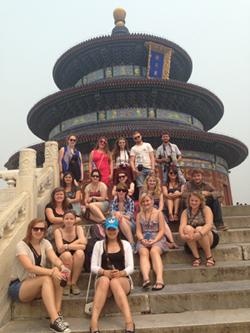
After lunch we will explore the Temple of Heaven
park. The complex was visited by the Emperors of the Ming and Qing
dynasties for annual ceremonies of prayer to Heaven for good harvest.
The Temple of Heaven park is best known for the Hall of Prayer for Good
Harvests, an iconic building famed for its magnificent triple-gabled
circular roof. You will also have an opportunity to walk the same
imperial walkway that the same emperors walked hundreds of years ago in
their holy rites. You will also see Beijing's senior citizens using the
park grounds for everything from tai chi and ballroom dancing to
bullwhip practice!
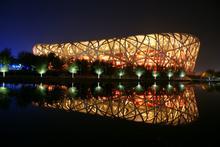 We'll then head to the northern area of Beijing, in
order to go to the Olympic Green. The Olympic Green was the center of
the event that captivated the world for two weeks in August of 2008, and
is where a majority of the Olympic events took place. The highlights
that you will see today include the Bird's Nest (officially known as the
Beijing National stadium) and the Water Cube (the Beijing National
Aquatics Center). The stadium gets its nickname from its outward design,
which originated from the study of Chinese ceramics, implementing steel
beams in order to hide supports for the retractable roof, thus giving
the stadium the appearance of a "Bird's Nest." The Bird's Nest hosted
the Opening and Closing Ceremonies, athletic events, and football final
of the 2008 Summer Olympics, from 8 August to 24 August 2008. Since the
Olympic's end, the Bird's Nest has been used to host events ranging from
opera to a ski park.
We'll then head to the northern area of Beijing, in
order to go to the Olympic Green. The Olympic Green was the center of
the event that captivated the world for two weeks in August of 2008, and
is where a majority of the Olympic events took place. The highlights
that you will see today include the Bird's Nest (officially known as the
Beijing National stadium) and the Water Cube (the Beijing National
Aquatics Center). The stadium gets its nickname from its outward design,
which originated from the study of Chinese ceramics, implementing steel
beams in order to hide supports for the retractable roof, thus giving
the stadium the appearance of a "Bird's Nest." The Bird's Nest hosted
the Opening and Closing Ceremonies, athletic events, and football final
of the 2008 Summer Olympics, from 8 August to 24 August 2008. Since the
Olympic's end, the Bird's Nest has been used to host events ranging from
opera to a ski park.
Afterwards we will drive to Tianjin Home Port
Xingang. Tianjin Port Xingang is about 200 km from Beijing and the drive
will take about 2-3 hours. We should arrive at Tianjin Home Port at
around 4:00pm or your designated time. Your tour guide will escort you
from the beginning to the end. Your tour guide and driver will give you
a hand in carrying your big pieces of luggage to the Tianjin Home Port
Xingang Cruise Terminal Building from the parking lot. Bon Voyage!

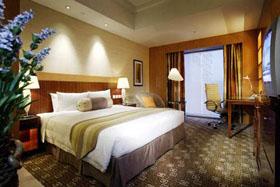

 Square. The largest public square in the world, Tiananmen
Square is seen as China's political center. Its grounds have seen some
turbulent moments, from the May 4th Movement of 1919 to the political
turmoil of 1989. The south of the square is marked by the Chairman Mao
Memorial Hall, while the center of the square is dominated by the
Monument to the People's Heroes, an imposing 10-story granite obelisk.
To the east is the National Museum of China, and to the west is the
Great Hall of the People, home to China's legislative bodies. The north
of the square is dominated by the Gate of Heavenly Peace, known for its
iconic portrait of Mao Zedong, and is the national emblem of China.
Square. The largest public square in the world, Tiananmen
Square is seen as China's political center. Its grounds have seen some
turbulent moments, from the May 4th Movement of 1919 to the political
turmoil of 1989. The south of the square is marked by the Chairman Mao
Memorial Hall, while the center of the square is dominated by the
Monument to the People's Heroes, an imposing 10-story granite obelisk.
To the east is the National Museum of China, and to the west is the
Great Hall of the People, home to China's legislative bodies. The north
of the square is dominated by the Gate of Heavenly Peace, known for its
iconic portrait of Mao Zedong, and is the national emblem of China.

